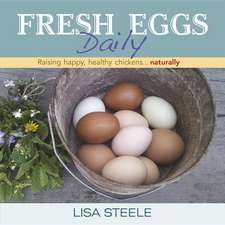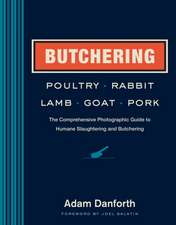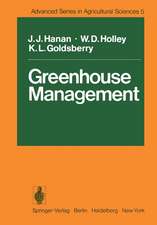Biotechnology and Ecology of Pollen: Proceedings of the International Conference on the Biotechnology and Ecology of Pollen, 9–11 July, 1985, University of Massachusetts, Amherst, MA, USA
Editat de David L. Mulcahy, Gabriella Bergamini Mulcahy, Ercole Ottavianoen Limba Engleză Paperback – 10 noi 2011
Preț: 1232.71 lei
Preț vechi: 1503.31 lei
-18% Nou
Puncte Express: 1849
Preț estimativ în valută:
235.91€ • 256.16$ • 198.16£
235.91€ • 256.16$ • 198.16£
Carte tipărită la comandă
Livrare economică 22 aprilie-06 mai
Preluare comenzi: 021 569.72.76
Specificații
ISBN-13: 9781461386247
ISBN-10: 1461386241
Pagini: 556
Ilustrații: XXIII, 528 p.
Dimensiuni: 170 x 244 x 29 mm
Greutate: 0.88 kg
Ediția:Softcover reprint of the original 1st ed. 1986
Editura: Springer
Colecția Springer
Locul publicării:New York, NY, United States
ISBN-10: 1461386241
Pagini: 556
Ilustrații: XXIII, 528 p.
Dimensiuni: 170 x 244 x 29 mm
Greutate: 0.88 kg
Ediția:Softcover reprint of the original 1st ed. 1986
Editura: Springer
Colecția Springer
Locul publicării:New York, NY, United States
Public țintă
ResearchDescriere
In Recognition of the Forgotten Generation D. L. MULCAHyl Pollen was long believed to serve primarily a single function, that of delivering male gametes to the egge A secondary and generally overlooked value of pollen is that it serves to block the transmission of many defective alleles and gene combinations into the next generation. This latter function comes about simply because pollen tubes carrying defective haploid genotypes frequently fail to complete growth through the entire length of the style. However, the beneficial consequences of this pollen selection are diluted by the fact that the same deleterious genotypes are often transmitted through the egg at strictly mendelian frequencies (Khush, 1973). Gene expression in the pollen might thus at least appear to be a phenomenon of trivial consequence. Indeed, Heslop-Harrison (1979) rightly termed the gametophytic portion of the angiosperm life cycle, the "forgotten generation." This neglect, however, came about despite subtle but constant indications that pollen is the site of intense gene activity and selection. For example, Mok and Peloquin (1975) demonstrated that relatively heterozygous diploid pollen shows heterotic characteristics whereas relatively homozygous diploid pOllen does not. This was proof positive that genes are expressed (that is, transcribed and translated) in the pollen. 1 Department of Botany, University of Massachusetts Amherst, MA 01003, USA viii However, the implications for pollen biology of even this recent and well known study were not widely recognized.
Cuprins
Gene Expression in Pollen.- Expression of ?-Galactosidase Gene in Pollen of Brassica campestris.- Identification of Duplicate Loci and Evidence for Post-meiotic Gene Expression in Pollen.- Gametophytic Gene Expression in Embryo-lethal Mutants of Arabidopsis thaliana.- Pollen Competitive Ability in Maize Selection and Single Gene Analysis.- Extent of Gene Expression at the Gametophytic Phase in Maize.- Male Gametophyte Response to High Temperature in Maize.- Genes and their Expression in the Male Gametophyte of Flowering Plants.- Pollen in Biotechnology.- Chromosome Engineering with Meiotic Mutants.- Intergeneric Crosses Between Zea and Pennisetum Reciprocally by In Vitro Methods.- Gametophyte Transformation in Maize (Zea mays, Gramineae).- Attempts to Transform for Kanamycin-Resistance in Mature Pollen of Tobacco.- Attempted Pollen-mediated Transformation using Ti-plasmids.- Dissolution of Pollen Intine and Release of Sporoplasts.- Sporophytic Screening and Gametophytic Verification of Phytotoxin Tolerance in Sugarbeet (Beta vulgaris L.).- Predicting Species Response to Ozone using a Pollen Screen.- In Vitro and in Vivo Effects of Acidity and Trace Elements on Pollen Function.- Alfalfa Pollen and Callus Responses to Fusarium.- Induction of Gametic Selection in situ by Stylar Application of Selective Agents.- Factors Influencing Artificial Gametophyte Selections using Synthetic Stigmas.- In Vitro Reaction Between Apple Pollen and Apple Scab Fungus (Venturia inaequalis Cke. Wint.).- Pollen Selection in Breeding Glasshouse Tomatoes for Low Energy Conditions.- Biochemical Alterations in the Sexual Partners Resulting from Environmental Conditions before Pollination Regulate Processes after Pollination.- The Use of In Vitro Methods in the Production of Pollen.- Maize Pollen Research: Preliminary Reports from Two Projects Investigating Gamete Selection.- Pollen Storage Effects on Early Seedling Growth in Maize.- Pollen Selection Through Storage: A Tool for Improving True Potato Seed Quality?.- Gametophytic Expression of Heavy Metal Tolerance.- Self-Incompatibility and Pollen-Style Interactions.- The Interaction Between Compatible or Compatible and Selfincompatible Pollen of Apple and Pear as Influenced by Pollination Interval and Orchard Temperature.- Pollen-Pistil Interaction.- Self-incompatibility Recognition and Inhibition in Nicotiana alata.- Role of Stigma in the Expression of Self-incompatibility in Crucifers in View of Genetic Analysis.- A New S-Allele and Specific S-Proteins Associated with Two S-Alleles in Nicotiana alata.- Immunodetection of S-gene Products on Nitrocellulose Electroblots.- Applications of a New Membrane Print Technique in Biotechnology.- Pollen-Stigma Interactions and S-Products in Brassica.- Isozyme Markers for the Incompatibility Loci in Rye.- Regulation of Pollen Germination and Overcoming the Incompatibility Mechanism in Brassica campestris by CO2.- A Cytoembryological Analysis of the Results of Different Types of Pollinations in Sugar Beet.- Selective Fertilization and Pseudocompatibility in Sugar Beet.- Self-incompatibility in Light of Population Structure and Inbreeding.- The Heterosis Model: A Progress Report.- Incompatibility and Incongruity: Two Mechanisms Preventing Gene Transfer Between Taxa.- Intra- and Interspecific Incompatibility in Brachiaria ruziziensis Germain et Evrard (Panicoideae).- Incompatibility Relationships in Intra- and Interspecific Crosses of Zinnia elegans Jacq. and Z. angustifolia HBK (Compositae).- Pollen Ultrastructure and Development.- Pollen Sterility in Hybrids and Species of Oenothera.- Fibrillar Structures in Nicotiana Pollen: Changes in Ultrastructure During Pollen Activation and Tube Emission.- The Male Germ Unit and Prospects for Biotechnology.- On the Male Germ Unit in an Angiosperm with Bicellular Pollen, Hippeastrum vitatum.- Isolation of Spinach Sperm Cells: 1: Ultrastructure and Three-dimensional Construction in the Mature Pollen Grain.- New Aspects of Sporopollenin Biosynthesis.- The Use of Gaspé Variety for the Study of Pollen and Anther Development in Maize.- Pollen Physiology and Metabolism.- Energy Metabolism in Petunia hybrida Anthers: A Comparison Between Fertile and Cytoplasmic Male Sterile Development.- Water Content, Membrane State and Pollen Physiology.- Do Anti-Oxidants and Local Anaesthetics Extend Pollen Longevity during Dry Storage?.- Protein Pattern of Apple Pollen in Culture: Effect of Actinomycin D.- Ion Localisation in the Stigma and Pollen Tube of Cereals.- Phytases of Germinating Lily Pollen.- Polyamine Biosynthesis in Germinating Apple Pollen.- Control of Protein Release from Germinating Pollen.- Metabolic Role of Boron in Germinating Pollen and Growing Pollen Tubes.- Complex Carbohydrates at the Interacting Surfaces during Pollen-Pistil Interactions in Nicotiana alata.- Biphasic Pollen Tube Growth in Plumbago zeylanica.- Absence of 10-Hydroxy-2-Decenoic Acid (10-HDA) in Bee-Collected Pollen.- Gametophytic Ecology.- Pollen and People.- Evidence For and Against Pollen Tube Competition in Natural Populations.- Pollen Competition in Aureolaria pedicularia.- Pollination Intensity, Fruit Maturation Pattern, and Offspring Quality in Cassia fasciculata (Leguminosae).- Variation of Reproductive Success Rates of Ovule and Pollen Deposited upon Stigmas According to the Different Number of Pollen on a Stigma in Angiosperm.- Effects of Pollen Load Size on Fruit Maturation and Sporophyte Quality in Zucchini.- Pollen Heteromorphism as a Tool in Studies of the Pollination Process in Pontederia cordata L..- Heterostyly and Microgametophytic Selection: The Effect of Pollen Competition on Sporophytic Vigor in Two Distylous Species.- Controlled Enpollination of Honeybees (Apis mellifera): Bee-to-Bee and Bee-to-Tree Pollen Transfer.- Population Dynamics of Open-pollinated Maize Synthetics under Non-random Fertilization Conditions.- Pollen Allocation in Wild Radish: Variation in Pollen Grain Size and Number.- Pollen Growth Following Self- and Cross-pollination in Geranium caespitosum James.- Incompatibility Reaction and Gametophytic Competition in Cichorium intybus L. (Compositae).- Cross-compatibility in an Annual Hermaphrodite Plant, Phlox drummondii Hook.- Environmental Stress Reduces Pollen Quality in Phlox: Compounding the Fitness Deficit.- Abstracts of Poster Presentations.- Author Index.









